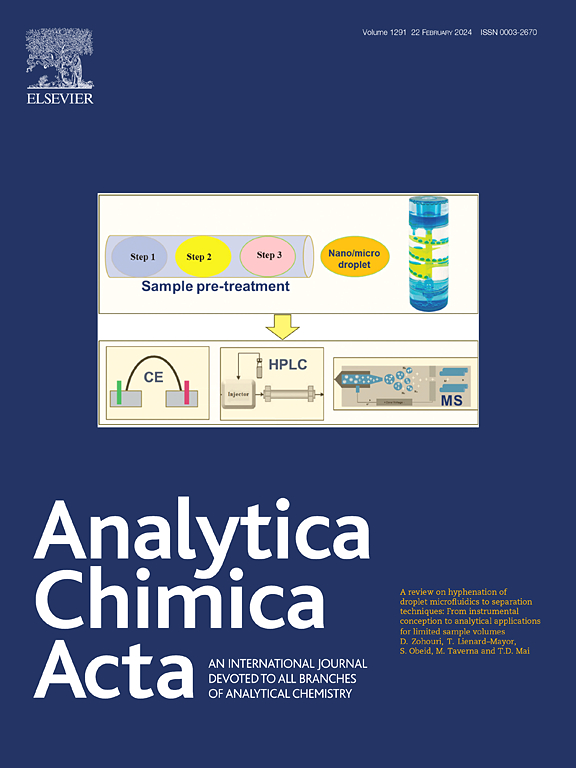一个直接的,实时的,大小分辨的分析策略,以跟踪药物装载和释放的生物相容性金纳米颗粒
IF 5.7
2区 化学
Q1 CHEMISTRY, ANALYTICAL
引用次数: 0
摘要
基于纳米颗粒的药物传递系统的分析方法通常依赖于非结合药物的定量来提供药物装载和传递的信息,但不能考虑系统的复杂性,解决释放系统的状态,或模拟生理环境。显然需要新的分析方法,能够在多参数分析平台的基础上,跟踪药物在生理条件下的装载、稳定性和释放的整个过程。不对称流场-流分馏(AF4)可用于粒度、分类和分离纳米颗粒,以便通过在线、不相关的技术进行进一步分析或表征。结果我们提出了AF4与在线多检测器耦合来研究由白蛋白(BSA)包被金纳米粒子(AuNPs)负载姜黄素(CUR)组成的模型药物递送系统。通过对实验参数的优化,加载效率最高可达88.9%。成功地提出了纳米载体在401 nm和530 nm处的吸光度比作为评价载药量(满载为0.77±0.01)和载药量释放的指标。在37°C时,Au-BSA-CUR表现出快速的药物释放,总释放量达到34.8%。这一过程伴随着药物的快速降解和有效扩散到周围的储存库(~ 30%)。在较低温度(20°C或30°C)下,在断裂图中出现新的吸光度峰(姜黄素聚集),表明疏水药物的特殊性质,这是AF4平台首次监测到的。我们的研究中采用的量身定制的策略提供了详细的、实时的、原位的分析,使其成为设计和优化药物传递系统的有力工具,提供了对加载和释放机制的洞察,评估纳米颗粒的稳定性,以及对盐水介质的耐受性。这些结果表明,AF4-DAD-MALS是研究纳米颗粒基药物传递系统的稳定性、装载效率和释放动力学的更可靠和有见解的技术。本文章由计算机程序翻译,如有差异,请以英文原文为准。

A direct, real-time, size-resolved analytical strategy to follow drug loading and release from biocompatible gold nanoparticles
Background
Analytical methods for the characterization of nanoparticle-based drug delivery systems often rely on the quantification of unbound drug to provide information on drug loading and delivery, but fail to account for system complexity, address the state of the releasing system, or simulate the physiological environment. There is a clear need for new analytical methods capable of following the entire process of drug loading, stability and release under physiological conditions, based on multi-parametric analytical platforms. Asymmetric flow field-flow fractionation (AF4) can be used to size sort and isolate nanoparticles for further analysis or characterization by online, uncorrelated techniques.
Results
We propose AF4 coupled with online multiple detectors to investigate the model drug delivery system consisting of albumin (BSA)-coated gold nanoparticles (AuNPs) loaded with curcumin (CUR). A maximum loading efficiency of 88.9% is achieved by optimizing various experimental parameters. The absorbance ratio of nanocarriers at 401 nm and 530 nm was successfully proposed as an index for evaluating drug loading (full load was 0.77±0.01) and release from the carrier surface. At 37 °C, Au-BSA-CUR exhibits rapid drug release, achieving 34.8% total release. This process is accompanied by swift degradation and efficient diffusion of the drug into the surrounding reservoir (∼30%). The appearance of new absorbance peaks in fractograms (curcumin aggregation) at lower temperatures (20 or 30 °C) indicates the special properties of hydrophobic drugs, which are monitored by the AF4 platform for the first time.
Significance
The tailored strategy employed in our investigation provided detailed, real-time, in situ analysis, making it a powerful tool for designing and optimizing drug delivery systems, providing insight into both loading and release mechanisms, assessing nanoparticle stability, and tolerating saline media. These results suggest that AF4-DAD-MALS is a more reliable and insightful technique for studying the stability, loading efficiency, and release dynamics of nanoparticle-based drug delivery systems.
求助全文
通过发布文献求助,成功后即可免费获取论文全文。
去求助
来源期刊

Analytica Chimica Acta
化学-分析化学
CiteScore
10.40
自引率
6.50%
发文量
1081
审稿时长
38 days
期刊介绍:
Analytica Chimica Acta has an open access mirror journal Analytica Chimica Acta: X, sharing the same aims and scope, editorial team, submission system and rigorous peer review.
Analytica Chimica Acta provides a forum for the rapid publication of original research, and critical, comprehensive reviews dealing with all aspects of fundamental and applied modern analytical chemistry. The journal welcomes the submission of research papers which report studies concerning the development of new and significant analytical methodologies. In determining the suitability of submitted articles for publication, particular scrutiny will be placed on the degree of novelty and impact of the research and the extent to which it adds to the existing body of knowledge in analytical chemistry.
 求助内容:
求助内容: 应助结果提醒方式:
应助结果提醒方式:


